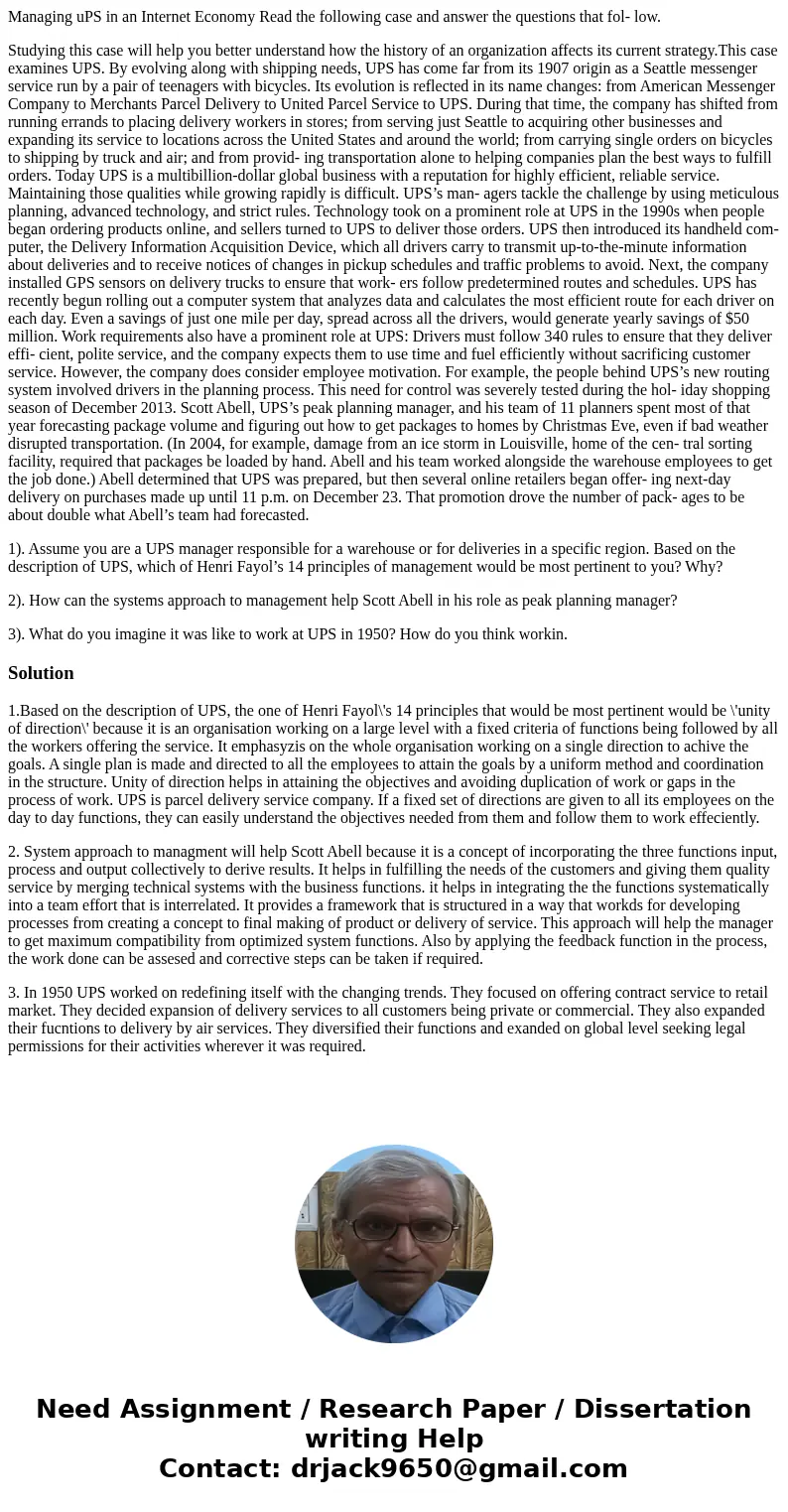Managing uPS in an Internet Economy Read the following case
Managing uPS in an Internet Economy Read the following case and answer the questions that fol- low.
Studying this case will help you better understand how the history of an organization affects its current strategy.This case examines UPS. By evolving along with shipping needs, UPS has come far from its 1907 origin as a Seattle messenger service run by a pair of teenagers with bicycles. Its evolution is reflected in its name changes: from American Messenger Company to Merchants Parcel Delivery to United Parcel Service to UPS. During that time, the company has shifted from running errands to placing delivery workers in stores; from serving just Seattle to acquiring other businesses and expanding its service to locations across the United States and around the world; from carrying single orders on bicycles to shipping by truck and air; and from provid- ing transportation alone to helping companies plan the best ways to fulfill orders. Today UPS is a multibillion-dollar global business with a reputation for highly efficient, reliable service. Maintaining those qualities while growing rapidly is difficult. UPS’s man- agers tackle the challenge by using meticulous planning, advanced technology, and strict rules. Technology took on a prominent role at UPS in the 1990s when people began ordering products online, and sellers turned to UPS to deliver those orders. UPS then introduced its handheld com- puter, the Delivery Information Acquisition Device, which all drivers carry to transmit up-to-the-minute information about deliveries and to receive notices of changes in pickup schedules and traffic problems to avoid. Next, the company installed GPS sensors on delivery trucks to ensure that work- ers follow predetermined routes and schedules. UPS has recently begun rolling out a computer system that analyzes data and calculates the most efficient route for each driver on each day. Even a savings of just one mile per day, spread across all the drivers, would generate yearly savings of $50 million. Work requirements also have a prominent role at UPS: Drivers must follow 340 rules to ensure that they deliver effi- cient, polite service, and the company expects them to use time and fuel efficiently without sacrificing customer service. However, the company does consider employee motivation. For example, the people behind UPS’s new routing system involved drivers in the planning process. This need for control was severely tested during the hol- iday shopping season of December 2013. Scott Abell, UPS’s peak planning manager, and his team of 11 planners spent most of that year forecasting package volume and figuring out how to get packages to homes by Christmas Eve, even if bad weather disrupted transportation. (In 2004, for example, damage from an ice storm in Louisville, home of the cen- tral sorting facility, required that packages be loaded by hand. Abell and his team worked alongside the warehouse employees to get the job done.) Abell determined that UPS was prepared, but then several online retailers began offer- ing next-day delivery on purchases made up until 11 p.m. on December 23. That promotion drove the number of pack- ages to be about double what Abell’s team had forecasted.
1). Assume you are a UPS manager responsible for a warehouse or for deliveries in a specific region. Based on the description of UPS, which of Henri Fayol’s 14 principles of management would be most pertinent to you? Why?
2). How can the systems approach to management help Scott Abell in his role as peak planning manager?
3). What do you imagine it was like to work at UPS in 1950? How do you think workin.
Solution
1.Based on the description of UPS, the one of Henri Fayol\'s 14 principles that would be most pertinent would be \'unity of direction\' because it is an organisation working on a large level with a fixed criteria of functions being followed by all the workers offering the service. It emphasyzis on the whole organisation working on a single direction to achive the goals. A single plan is made and directed to all the employees to attain the goals by a uniform method and coordination in the structure. Unity of direction helps in attaining the objectives and avoiding duplication of work or gaps in the process of work. UPS is parcel delivery service company. If a fixed set of directions are given to all its employees on the day to day functions, they can easily understand the objectives needed from them and follow them to work effeciently.
2. System approach to managment will help Scott Abell because it is a concept of incorporating the three functions input, process and output collectively to derive results. It helps in fulfilling the needs of the customers and giving them quality service by merging technical systems with the business functions. it helps in integrating the the functions systematically into a team effort that is interrelated. It provides a framework that is structured in a way that workds for developing processes from creating a concept to final making of product or delivery of service. This approach will help the manager to get maximum compatibility from optimized system functions. Also by applying the feedback function in the process, the work done can be assesed and corrective steps can be taken if required.
3. In 1950 UPS worked on redefining itself with the changing trends. They focused on offering contract service to retail market. They decided expansion of delivery services to all customers being private or commercial. They also expanded their fucntions to delivery by air services. They diversified their functions and exanded on global level seeking legal permissions for their activities wherever it was required.

 Homework Sourse
Homework Sourse